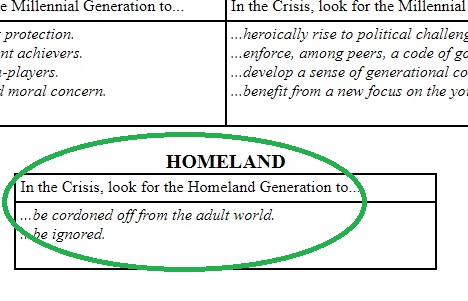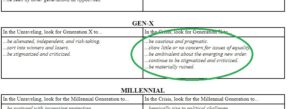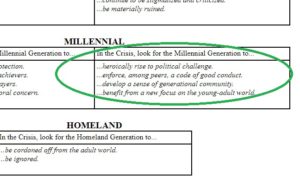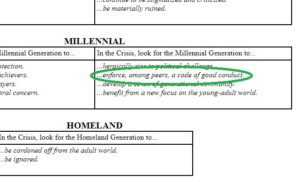Growing Up in Crisis America
When one reads in online media about the generations that are alive today, it is most typically a story contrasting the Baby Boomers with the up and coming Millennials. Sometimes my generation, Generation X, gets a mention. In other blog posts, I have referred to the Silent Generation. You may even have read about the post-Millennial Generation Z, usually said to have been born starting some time in the late 1990s.
Clearly some generation must follow the Millennials, but I have my doubts about the Gen-Z concept. In the generational theory which I study, the next generation, still in childhood, is called the Homeland generation. This name was coined early in the century, around the time that the Department of Homeland Security was instituted in response to 9/11. The name evokes the idea of a country entering protective mode, and of a generation that is sequestered within it.

With the first birth year of the Homeland generation being 2005, the oldest of their members are just turning 14. What can we say about this child generation and their experience growing up in an America in crisis?
The Homeland generation has clearly been the beneficiary of the restoration of the American family that began when Millennials started being born in the 1980s. The era of rising protection of children has reached its apex; children are now completely ensconced within the family unit. You can see it online in social media with the endless stream of posts of happy families headed by Gen-X parents – and, increasingly, by Millennial parents.
Protective child nurturing has reached the point that there is are hints of concern that overprotection has gone too far. But despite memes extolling the free-wheeling child rearing of days past, there is little sign of the protection relenting. Instead, in a shift away from the way that Millennials were raised, Homelanders are being taught not so much that they are special and unique, as that they must learn to fit in and to get along with others. It’s a trend propelled by concern for the perceived negative consequences of being a social misfit in a time of rising suicide rates and mass shootings, or of standing out in an era of social media scrutiny.
Homelanders, in fact, are the first generation to have their entire lives documented on social media. It starts when they are still in the womb, with sonograms posted by excited expecting couples. Then comes a flurry of adorable toddler posts, capturing every precious moment. Once they hit school age, there is a mandatory start of the school year portrait for every grade from kindergarten on. My favorite indicator on social media of the centrality of family in American life, and the Homelander generation’s comfortable place within it, is the themed costume group photos that come out every Halloween.
It seems to me like Homelanders are always on exhibit. If not as the trophies of proud parents and grandparents, there are two prevalent ways in which Homelanders are put on display. One is the viral video featuring a toddler in some moment of discovery or precious and adorable behavior. Follow this link for a great example.
The other prevalent way that Homelanders are put on display is in the role of victims, as object lessons about the failures of our society. Movies like The Florida Project and Beasts of the Southern Wild portray young children in trying circumstances, on the economic fringes American life. Another example, What Maisie Knew, warns of the follies of the affluent and the damage that divorce and neglect do to a child.

The Homelanders who are truly on the fringes of American life are the undocumented migrants – their status raises doubts that they even belong to the homeland at all. The political left has made ample use of images of their tribulations to protest immigration policy. One photo of a crying toddler being processed by immigration authorities has become an iconic representation of these suffering innocents, caught on the edges of a fragmented society that is, with difficulty, trying to group itself back together.
In conclusion, the Homelander experience is reflective of the needs and priorities of their Gen-X and Millennial parents – to restore family stability, and to provide a controlled and safe environment for child nurture within a society that feels out of control and unsafe. With these goals in mind, children are being taught that rather than stand out, they should fit in. Rather than express emotions, they should manage emotions.
This is the opposite of how Generation X was raised half a century ago, at a time when family stability was not a priority, and parents sought to provide a free environment within a society that felt overly controlled and limiting. The reversal is a response by Gen-X, conscious of the failings their generation has faced as a consequence of lax parenting. Today’s parents will surely make there own mistakes, as all parents do, taking on what is the most difficult of all human endeavors. They will take things too far, and so set up the course corrections that will lead to another shift in how children are raised, for a new generation yet to be born.
To end this post on a positive note, here is a wonderful example of an adorable young Homelander viral video. These kids are our future.

 Let’s look at the remaining items on the list of predictions about the Millennial generation – that Millennials will heroically rise to political challenge, that they will develop a sense of generational community, and that they will benefit from a new focus on the young-adult world. For evidence, I will simply consider the kinds of news stories that have been prevalent on social media and the web in the past decade. So let’s start with the last item on the list.
Let’s look at the remaining items on the list of predictions about the Millennial generation – that Millennials will heroically rise to political challenge, that they will develop a sense of generational community, and that they will benefit from a new focus on the young-adult world. For evidence, I will simply consider the kinds of news stories that have been prevalent on social media and the web in the past decade. So let’s start with the last item on the list.